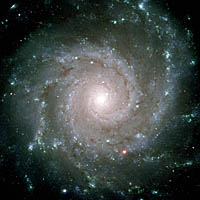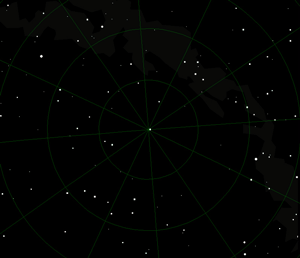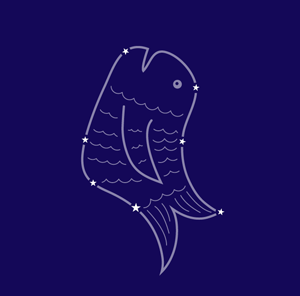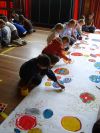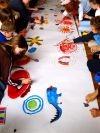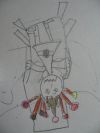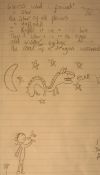Highland Constellation Project
For the Highland Constellation Co-reult na Gàidhealtachd project pupils selected a star for their area. Once each area had a star, they were joined up to identify the new Highland Constellation and a competition was held to name it.
Click on the image to see a larger version of the stars chosen for the Highland Constellation.
New Constellation found in the Highlands!
The Highland Constellation Co-reult na Gàidhealtachd
The Star Girls -Gill, Linda and Rachel - have been working with The Royal Observatory Edinburgh and local schools to identify a new constellation in the skies above the region in a project run by the Highland Council Exhibitions Unit to celebrate 2007, Scotland’s Year of Highland Culture. The project brings together astronomy, digital art, craft and literature.
For the Highland Constellation Co-reult na Gàidhealtachd project pupils selected dates significant to them from Highland history and plotted them in light years from the earth. They then select a star for their area and developed stories related to this date in their local history. Once each area had a star they were joined up to identify the Highland Constellation and a competition was launched to name it.
The competition was won by Ullapool pupil, Alexander Stewart with his winning design, Jumping Fish Iasg a’ Leum. The selection team were unanimous in their decision as they felt that Alexander’s design reflected the Highlands history and future and was an easily recognisable shape for people to identify in the night sky.
This design and name will now be recognised as the Highland Constellation and will be translated by Gill Russell into her new land artwork in Glenuig. It will also be used in all publicity and for merchandising related to the project.
Second prize was awarded to Jessamy Cowie from Cawdor with ‘Vada Copag the white horse.
Third Prize went to Alice Burgoyne from Brora for ‘Tear Dropped Feather’
The response to the competition was so high that we felt we had to add a ‘commended’ category.
Primary Category: ‘The mole who found his way’ by Caitlin Whittle from Kyle of Lochalsh. ‘The Windy Sky’ by Daisy Mackenzie from Brora.
High School Category: ‘Muc-Mhara’ by Bethany Nairn and ‘Clarsach’ by Oonach White both from Ullapool.
The project continued over the summer with Linda Cracknell developing her own writing for the project. It is anticipated that this will be published in the spring of 2008. The pupils submitted their writing from Linda’s workshops and several pieces will be included in the published book and in the art book that Rachel Hazell will be creating for the project. The standard of writing submitted was extremely high, reflecting Linda’s considerable talent for drawing out the best in her participants.
Rachel Hazell goes to all the participating schools in September to create her Book Rocket with them – one for each star.
Gill Russell is now ‘in residence’ in Glenuig to create her land artwork to reflect the project. The project will culminate in a grand final event on 17th November in Glenuig, where the newly completed installation, the Highland Constellation Book and the Book Rockets will be launched.
Notes:
- For more information on Linda Cracknell visit: lindacracknell.blogspot.com
- For more information on Gill Russell visit:www.cosmicsky.co.uk
- For more information on Rachel Hazell visit: www.hazelldesignsbooks.co.uk
Partners:
The Highland Constellation Co-reult na Gàidhealtachd is funded by Scottish Arts Council National Lottery partners programme, The Highland Council and Highland 2007 with support from the Royal Observatory Edinburgh
Highland 2007, the year Scotland celebrates Highland culture, aims to promote the Highlands and Islands as a great place to live and to visit through showcasing the unique and special nature of Highland culture past, present and future. The project is a partnership between three principal funding agencies: The Highland Council, the Scottish Executive, and Highlands and Islands Enterprise. The year long celebration of Highland culture in 2007 will incorporate an exciting range of major and community events, as well as capital projects and ‘The Highland Promise’ for young people. See www.highland2007.com for full details. Highland 2007 is the first themed year planned by the Scottish Executive to promote Scotland as a great place to live and to visit.
Inverness Schools Group:
Muirtown, Dochgarroch, Kinmylies, Teannassie, Kirkhill and Beauly Primary Schools
The final star in our constellation was chosen by the Inverness Schools group at Muirtown Primary on 7th June : Gamma Cassiopeiae won the majority vote with Schedar following closely in second place.
Gamma Cassiopeiae ( Cas / Cassiopeiae) is a hot blue star 615 light years away and about 5400 times as bright as our Sun
It is located at the centre of the distinctive "W" shape that forms the constellation of Cassiopeia but has no traditional Arabic or Latin name. In Chinese, however, it has the name Tsih, meaning "the whip".
Gamma Cassiopeiae is an interesting star in that it actually changes brightness over the years. While most stars (like our own Sun) are of almost constant brightness, many stars undergo significant variations in brightness, and these are known as variable stars. Gamma Cassiopeiae is an eruptive variable star, whose brightness changes irregularly Although today it is the brightest star in Cassiopeiae, in 1940 it was such a dim star that it would not have made it into our star selection for the Highland Constellation!
The light we see from Gamma Cassiopeiae today left in the year 1392. The 14th century was a time of chop and change in the monarchy of Scotland. In 1390 Robert II died and was replaced by his son Robert III and establishing the Stewart dynasty. In addition it was in the mid 14th century that the plague had reached much of Scotland.
Children in the Inverness schools pictured Queen Cassiopeia circling around the Pole Star, clinging to her throne. Sent there as a punishment for bragging about her beauty, the children couldn’t help have a bit of sympathy for her discomfort, and the fact that she is never out of sight.
Plockton High
Space Melody
The endless vacuum wicker wacks
and sprondleflops in space,
the crazy hogspit nebula
sporefecks all over the place,
the sun nearby called sethaphor who lives its final days
burns and pops and rips and rots and never
ceases to amaze!
the aliens from planet Sprog fly merrily by
they’ve come from forty light years away
just to see the old sun die
the comets shoot by really fast
it’s awesome to behold!
there’s fast things and slow things
and things that look like mould
wiz pop, wiz bang, foosh and flop,
goes the comet proudly
shoops, nosh, wiz, bop
yells the comet loudly
so there you go we’re at the end
I hope you will agree
this poem is not that bad
a proper space melody.
Max Reiter, 3C, Plockton High School
Plockton High School chose the star Alderamin.
Alderamin is a yellow star similar to our Sun albeit somewhat hotter and larger. The name Alderamin means ‘the right arm’. It is the brightest star in the constellation Cepheus the King.
Alderamin is 49 light years away and we were seeing it as it was in the year 1958. This is a significant date for Plockton High School as it was during this time that the famous Gaelic poet Sorley Maclean was headmaster there.
1958 was also the year that the first artificial satellite Sputnik 1(launched 1957 by the Russians) fell to Earth from its orbit. This was followed closely by the USA launching a satellite of its own and beginning the Space Race.
Alderamin will one day, be our Pole Star. This is because every 25,000 years the earth’s North Pole traces a circle in the sky (analogous to a spinning top which wobbles) and as it does so it points to different stars. Today the Earth’s North Pole points to Polaris, our current pole star. Alderamin is also located on the path of this ‘precessional circle’ so in 7500 AD Alderamin will be our Pole Star.
Kyle/Kyleakin
Moonlit Skies
The apple fell to the ground with a thud.
I sliced it open and the juice poured out.
Then the star was unleashed.
I slipped it onto a chain and wore it for the day.
It was beautiful but fading.
I blew a bubble and locked the star inside.
I blew on it making it go further up.
Once it reached the atmosphere the bubble popped but now the star twinkled
and shone more than ever.
From then on my star never moved even though others did.
My star still stood, shimmering, pointing North.
I named my star Polaris
Shannon Ailin Campbell, Kyle of Lochalsh Primary School
On 29th May, Kyle/Kyleakin primary schools chose their star: Aldhibain.
Aldhibain is a yellow star about 70 times as bright as our Sun in the constellation of Draco (the Dragon).
It lies about 88 light years away and has a significant connection to the history of the Kyle/Kyleakin area , marking the date of the tragedy of the sinking of the IOLAIRE in 1919.
The Iolaire was carrying soldiers who had fought in the First World War back to the Scottish island of Lewis. She left the port of Kyle of Lochalsh on the mainland late on the evening of the 31 December 1918. But, at 2:30am on New Year's Day, as the ship approached the port of Stornoway, a few yards offshore and a mile away from the safety of Stornoway Harbour, she hit the infamous rocks "The Beasts of Holm", and eventually sank.
The ship was badly overcrowded and the soldiers were wearing their full uniforms including heavy boots, so swimming from the wreck was by no means easy. Those who jumped overboard were lucky if they escaped and 73% perished in the incident.
Many songs and poems, such as "An Iolaire (The Eagle)", describe the women of these men finding their men washed up on the shore the next day. This was, the worst peacetime disaster involving a British ship since the Titanic on April 15, 1912.There is a recently erected memorial at Holm, outside Stornoway, to those who lost their lives in the tragedy.
Portree and Broadford Schools
Kochab
Kochab, you are
Our star. You see
Crofters throwing sticks and stones and more
Helping us to flight bravely
At the
Battle of the Braes.
On the 24th May 2007, Portree and Broadford schools chose their new star:
Kochab.
Kochab was a clear cut winner and inspired the imaginations of the pupils as it relates very much to local Highland History.
Kochab is in the constellation of the Little Bear Ursa Minor. It is an orange star about 1000 times as bright as the Sun.
The Battle of the Braes
Once more MacDonald's anger broke
'Invade the isle of Skye!'
'Two thousand soldiers boats and guns
The people must comply'
'Oh if we send one million men'
In London they declared
'We'll never clear the Isle of Skye
The people are not scared'
Kochab is 125 light years away and the light that we see from Kochab left about 1880-around the time of the Battle of the Braes in the Island of Skye . The Battle of the Braes was very significant in Highland history as it marked the end of the Highland Clearances. The brave crofters of the Braes area in Skye stood up against the eviction order by Lord Macdonald and armed with only sticks and stones rose up against policeman and won the battle. This was reportedly the last battle fought on British soil.
The area known as Braes lies close to Portree, the main town in Skye.
Ullapool High School
Polaris
Polaris, you are a map of the North
Polaris, your beam is as sharp as a hunter’s spear
You’re glued to the centre of the Universe
and the beginning of another
Your bearing guides us through the night
Polaris, you’re our chosen star.
Olivia, Dan, Seumas, Sarah
Ullapool High School
Ullapool chose a unique star: Polaris.
Polaris is also called the North Star or the Pole Star. It is directly above the North Pole - the Earths axis of rotation, so as the Earth spins on its axis, Polaris is unique in that it appears to stay still while all the other stars appear to rotate around it.
As it is above our North Pole, it has been used as a guiding star by explorers and navigators for centuries- if you follow the North Star , you end up going North.
Polaris is in the tail of the constellation Ursa Minor, The Little Bear (near the Plough and Ursa Major, the Big Bear). It is a relatively bright white star about 432 light years away.
Polaris is about 50 times bigger than our Sun and at least 2600 times as bright.
The light we see from Polaris today left in the year 1575. This was during the troubled life of Mary Queen of Scots and during her 18 year confinement by her cousin, Queen Elizabeth I, who perceived her as a threat to the English throne. Mary was ultimately convicted of treason, and was sentenced to a beheading in 1587.
Brora Primary School
What Vega Sees
What I see is 1982
I see a soldier with shaking hands
I see him holding a gun
I see him fighting in the Falkland War
What I see is 1982
I see Bronwen’s Dad leaving school
I see Bronwen’s Mum has got two years left
I see the first baby smile of Prince William
What I see is 1982
I see people doing Michael Jackson’s moonwalk
I see men with long hair
I see men with lots of denim
What I see is 1982
By Bronwen, P5/6 Brora Primary School
Cawdor may have chosen the biggest star but on May 8th primary 5/6 classes from Brora Primary School chose the brightest star - Vega. Vega is the jewel in the constellation Lyra the Winged Harp and is a hot white star.
Vega looks close to Deneb in the sky as part of the Summer Triangle, but they are actually very far apart. Vega is only 25 light years from the earth, while Deneb is 3232 light years away! Although Vega looks the brightest star in our range of stars, it is only just over 3 times as big as our sun and only 61 times as bright. (Most of the stars in the sky that we can see are brighter than our Sun).
So we are seeing Vega as it was in 1982, before the time of mobile phones...when Prince William was born ...when woman liked to wear shoulder pads ...and when Phil Collins and Queen were top of the pops!
Cawdor Primary School
We will send to Deneb…
We will send to our star
a dolphin leaping out of the sparkling water of the Moray Firth
a Chinese kite with bright red eyes
a cousin coming down the aisle in a wedding frock.
We will send to our star
a segment of sweet orange slipping down a throat
galaxy chocolate melting on the tip of our tongues
the glowing warmth from within a house.
We will send to our star
the feel we get from a computer game high score
a cat’s fur standing on end
the smash of front forks on a bike.
We will send to our star
the shout of a trumpet’s note
a football getting kicked in the air
the ‘boing’ of the trampoline.
We will send to our star
the sound of rain tapping on the roof
crickets’ wings in the early evening
cows mooing in the moonlight.
We will send our message on a spaceship shaped like a swan.
When its wings are stretched out they will be as big as our playground,
each leg like Big Ben.
After three thousand light years, the swan will reach the star.
Elegant and quiet, it will touch down,
spit the message from its beak,
and melt our words onto Deneb’s scorching surface.
Then the swan will turn for home.
Written by the children of P5/6 Cawdor Primary School, 1st May 2007
(with thanks to Kit Wright’s ‘Magic Box’)
The first star for our new Highland Constellation was chosen by Cawdor Primary school on 30 April.
The children from primary 5/6 studied star maps and diagrams of distance, brightness, colour , size and luminosity and gave their favourites marks out of ten. Deneb was a clear winner over Vega in second place , Capella in third place and The North Star in fourth place.
Deneb means 'tail' and is in the tail of the constellation Cygnus the Swan. The children saw the figure of Cygnus the Swan and their star Deneb in the mobile planetarium dome. Deneb is a bright star and part of the three stars that make up the Summer triangle -along with Vega and Altair. It is a hot white star and has a diameter 259 times that of our Sun. Deneb is also 301,000 times as bright as our Sun, making it the biggest on our map!
Deneb is the furthest star on our map at about 3232 light years or 19,392 million million miles away. The light that we see from Deneb left in 1225BC around the time of the Bronze Age. Just along the road from Cawdor is the Clava Cairns - one of the best preserved Bronze Age burial sites in Scotland. The cairns are surrounded by standing stones, with passageways aligned to the midwinter sunset.





Pamela Conacher
Highland Constellation
01687 470320
07818 682505
Pamela.Conacher@care4free.net
